|
|
| Several RC magazines around the world have asked us to write a monthly column. With the kind permission we will re-publish the column at our web site too so all of the XRAY fans can read the latest news and behind the scenes information. Enjoy. |
|
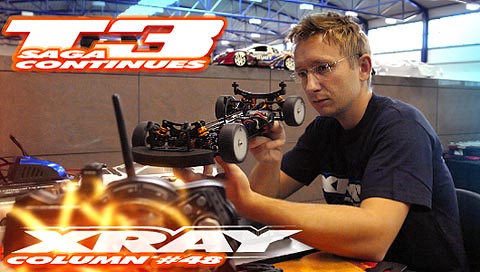
(click to enlarge) |
|
|
|
After a very successful carpet season â“ where the T3 succeed very well by gaining many national titles as well as many very good international results â“ we were looking forward to driving on asphalt. At this time we started thinking about possible improvements for next year to keep XRAY ahead of all the other brands of electric touring cars. It was a challenge to find faults with the current car because the T3 was very good not only on carpet but also on asphalt. This was proven by Paul Lemieux, who won the coveted Reedy Race amongst many top touring car racers. However, there are always some details or parts which can be improved upon.
Due to advancements in electronics in recent years, we have changed with the times and moved from brushed to brushless motors, and from NiMH to LiPo batteries. The T3 was designed for both LiPo and NiMH at its debut; some racers still used NiMH batteries, so we didnâ™t want the T3 to be LiPo only because many customers could be disappointed. However, LiPo popularity has increased dramatically and after 1 year almost nobody uses "classic, old-school NiMH batteries." It was time to go LiPo only. |
|
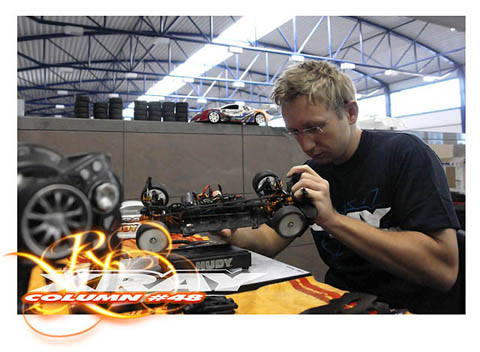
(click to enlarge) |
|
|
|
Even though the T3 is a perfect car for low- and medium-traction conditions on both carpet and asphalt, we started to face a few small issues in high-grip conditions. The car started to be more difficult to drive into corners because it had too much steering. When drivers changed their set-up to decrease steering to make car easier to drive, they lost mid-corner steering and out-of-corner steering⦠not good. We therefore decided to try a double steering system which gives different right and left wheel angles while turning. Initial testing was held at our three tracks ⓠcarpet track, indoor technical asphalt track, and outside open asphalt track.
The first test was surprising because on the carpet and indoor asphalt track, we could not feel any difference between single and double steering; car handling and lap times were the same. However, on the big open asphalt track we finally could feel the difference. The car had a little less steering into the corner but in the middle of the corner there was more steering than single steering system. This was what we were searching for last year. Of course the difference is not huge and average drivers may not notice the difference between single and dual steering, but experienced drivers should notice the improvement in mid-corner steering. |
|
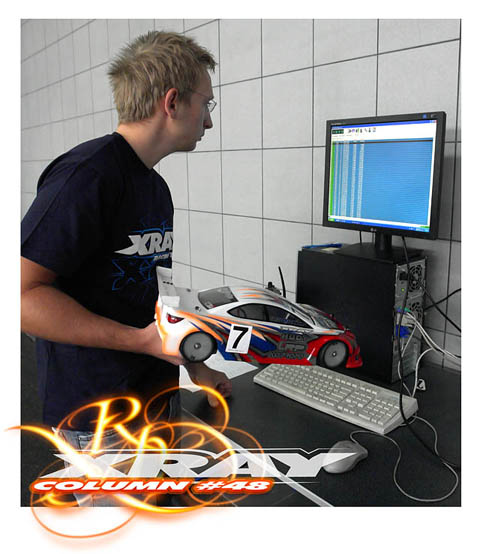
(click to enlarge) |
|
|
|
The decision was made to go to a double steering system. The goal was to create the best balance using LiPo batteries, and we had to consider the weight of 1350g which had to be balanced equally. As such we came up with the unique idea to orient the servo horizontally and locate the servo saver at the center of chassis. With this new servo position came several advantages. The weight is more in the center to give the car better left-right balance, which also makes the car more responsive and stable through chicanes. With the servo linkage in the center, it is not influenced by chassis flex. And thanks to the central servo placement we could make the chassis narrower, much narrower than other cars.
With all these enhancements and advantages, we started designing a super narrow chassis. First we tested an 80mm-wide chassis (narrower by 15mm than any other car); this chassis worked well on low-to-mid traction tracks, but on high-grip tracks treated with sugar water, the car was pushing. We determined that the car was flexing too much with this chassis. Therefore we started testing different chassis widths and we ended up with a 94mm-wide chassis which gave the best combination of traction and responsiveness. We tested over 8 different chassis widths on more than 8 tracks, and this chassis worked the best on all of them. |
|
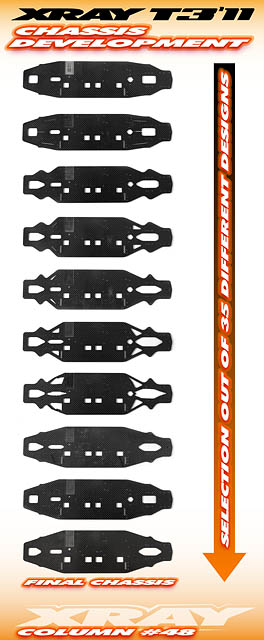
|
|
|
|
The second aim of the new chassis was design. We were testing different shapes to get the best possible traction and steering. Every small groove, cut, and change in chassis shape influencing the performance of the chassis. We tried to affect flex on the chassis by making cuts in the chassis behind the front suspension and in front of rear suspension. These cuts would allow flexing where the suspensions are situated, and in theory this chassis shape should increase steering and traction. This chassis worked well on low traction tracks, but on high-traction tracks the car had simply too much traction which lead to tire overheating and made the car more difficult to drive.
After designing and testing various shapes, we returned to the original shape to get optimal traction and steering. We also altered the cutouts in the center of chassis by expanding the cutouts for the front and rear diff and in places where gearing is situated, however the chassis was flexing too much which was not good for carpet racing. Therefore we decided to make smaller cutouts. In total we tested 35 different chassis shapes & cutouts, materials, and thicknesses to find the best one. |
|
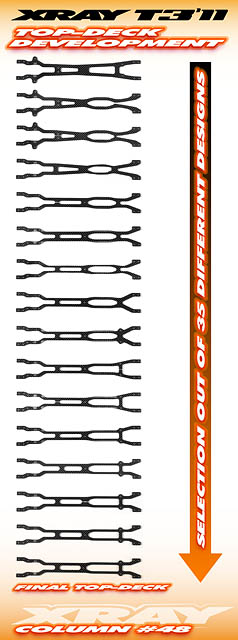
|
|
|
|
Another big design challenge was the top deck. Again we were testing different shapes, focusing primarily on the front part of the top deck which highly influences chassis flex â“ steering, traction, and consistency. We tried over 35 different top deck shapes, and it was amazing to see how each small change made a big difference at the track. We focused on three different front end shapes: V-style, U-style, and fork. The âśV-styleâť worked very well on asphalt but not on carpet, while the âśU-styleâť had the opposite effect. Therefore we developed a top deck somewhere in the middle to combine the best characteristics from both, and this top deck worked very well on both surfaces.
When we had settled on a front end design, we then focused on thicknesses as well as positions of inside cuts. We were shocked how big an influence the thickness had. We were testing different thicknesses in the front, middle, and rear of the top deck. Even changing the thickness from 4.5 to 4mm had a huge effect on performance. After many different combinations and permutations, we choose the top deck that worked best for all traction conditions and surfaces.
Last year, we as well as others had some problems with traction rolling when some particularly high-traction tires were used at big races. To make the car work well in these conditions, we created two aluminum stands that connect the top deck with the double steering stands. By adding these stands, the car works very well in high-grip conditions. |
|
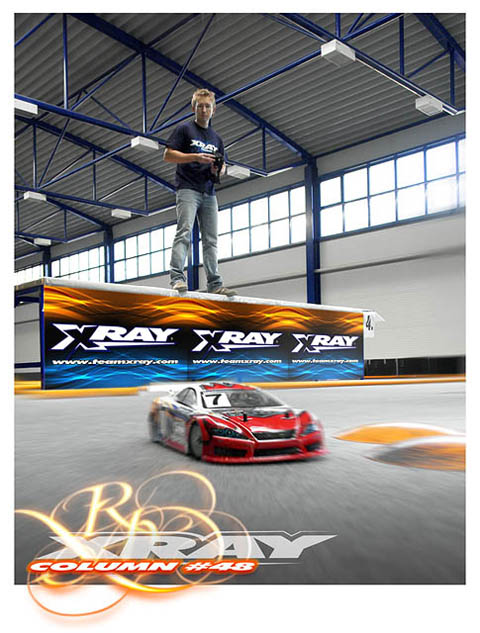
(click to enlarge) |
|
|
|
After 3 months of intensive testing â“ where we were testing nearly every day from afternoon to late evening and over the weekends at the races â“ we came up with a car that works well not only at low-to-mid traction tracks, but also at high-traction tracks and mainly at asphalt tracks. And so the T3â™11 was born.
The electric touring category is one of the most highly-competitive categories, where every small difference makes a huge impact on the performance of the car. Over the last decade, the development of electric touring cars has made huge progress; the maturity in this category is clearly shown as a large percentage of electric touring cars â“ even amongst different manufacturers â“ have very similar designs. It is the same case for the 1/12 pan car and even 1/8 on-road categories â“ some of the oldest categories â“ where the smallest details have been so well designed and developed over the decades. Even though the cars nowadays may look similar or same, the fact is that the smallest details, materials, tolerances, etc are now the key factors that differentiate the cars. Luckily this is an area where XRAY has always been strong and in the end it is the customer who decides where s/he spends his money.
Now⦠time to hit the indoor tracks and start the 2010/2011 winter season! |
|

|
See you around the tracks. Enjoy the ride and â�til next time.
Dipl. Eng. Juraj Hudy
XRAY Chief Designer |
| Archive: |
|
Column #1 - Behind the Scene Stories
Column #2 - Worlds Flashback
Column #3 - T2'007 Debut
Column #4 - Designing the T2'007
Column #5 - Worldcup Review and NT1 Testing
Column #6 - Developing and Designing the NT1
Column #7 - Developing and Designing the NT1 - Part 2
Column #8 - Back to the Races
Column #9 - XT8 Truggy Development
Column #10 - Touring Car Development
Column #11 - Bling-bling Mentality
Column #12 - Hot Summer Washout
Column #13 - New Electric Touring Car
Column #14 - Off-road Development
Column #15 - My micro love
Column #16 - Back in the Dirt
Column #17 - Worlds Preparations
Column #18 - 808 Tests & Stress
Column #19 - Excited for the Worlds?
Column #20 - Statistics, Expenses Sheets, Production Analysis, Calculationsâ¦
Column #21 + Column #22 - Euros + Euros + Worlds
Column #23 - The Busiest Season Ever
Column #24 - In Between the Worlds
Column #25 + Column #26 - Well Developed or Overdeveloped?
Column #27 - Back to The Future
Column #28 - 2009 Kick-off
Column #29 - Crazy what?
Column #30 - Last indoor race of the season
Column #31 - Getting into summer season
Column #32 - Heading for the Euros
Column #33 - Testing - Always last minute, always new ideas
Column #34 - European Champion - title celebration
Column #35 - Time to move on
Column #36 - National Heroes
Column #37 - 2010 ready
Column #38 - Decade of Triumph
Column #39 - 2010 Racing Calendar
Column #40 - DHI, ETS & NĂĽrnberg Show
Column #41 - World Championship Practice
Column #42 - EC indoor, EC 1/12, Silverstate, LRP Masters, Neo
Column #43 - Nationals All Around
Column #44 - Warm Warm-ups, Challenging Challenges
Column #45 - Electric Touring Worlds 2010
Column #46 - Team XRAY - World Champion!!!
Column #47 - Summer Vacation, 30x USA Champion Title |
|























